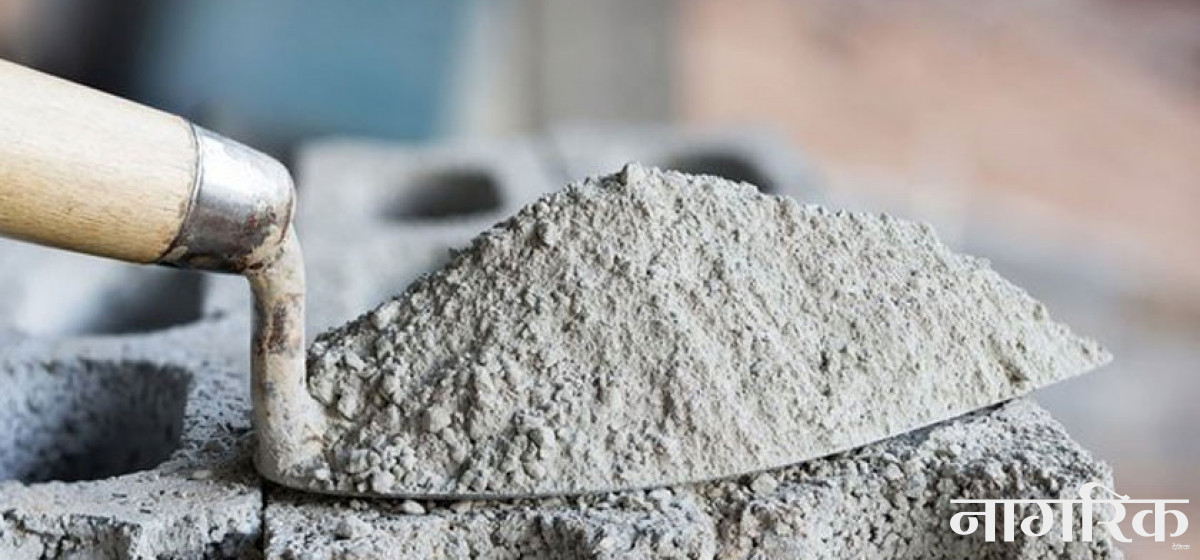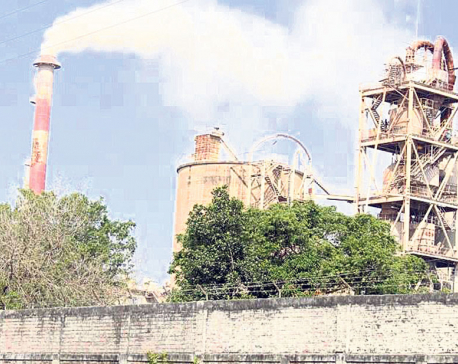
OR
Cement production cut down by 70 percent
Published On: January 29, 2023 09:30 AM NPT By: Dilip Paudel

KATHMANDU, Jan 27: The cement industry has cut its production by up to 70 percent due to the drop in demand in the market. Due to the heavy decline in the demand for cement due to stagnation of development projects resulting from liquidity crisis in banks, reduction in capital expenditure, lack of construction materials, the production has been affected.
Dhruba Thapa, president of Nepal Cement Manufacturers Association, said that since there is no demand for cement in the market, the production capacity has shrunk to 25/30 percent. "The production had to be reduced after the huge decline in sales of cement," President Thapa said, adding, “If this situation continues, more than a dozen industries will have to shut down this year.”
President Thapa said that the cement industry was affected when the bank did not give loans to hydropower projects, when the government did not release the budget, and when the crusher industry was closed. He said that when the construction sector is affected, it impacts the overall economy.
President Thapa said that the annual cement turnover is about Rs 150 billion, but this year the turnover is expected to be very low. "Decline in consumption of cement means that development and construction is affected," Thapa said, "It will affect the development and economy of the country." He estimated that it will be difficult to meet a transaction of even Rs 800 million this year."It was expected that cement consumption would increase by 10 percent annually," he said, "Instead of increasing, the demand has decreased significantly."
There are six and a half dozen cement industries in the country. The production capacity of the cement industry in Nepal has reached about 20.5 million tons. Industrialists have said that the cement industry is in trouble as the construction of development projects has stopped due to the closure of the crusher industry.
Pashupati Murarka, owner of Arghakhanchi Cement, said that the cement industry has slashed production due to lack of sales in the market. "The production has decreased because the demand for cement has decreased," he said. “Due to the lack of gravel and sand, development projects have been affected, and the cement industry has also been affected," Murarka, who is also the former president of the Federation of Nepalese Chambers of Commerce and Industry (FNCCI), said,
"In the past, they used to search for markets after the production, but now they are producing only on the basis of demand.” As the government clamped down on the crusher industry, there has been a shortage of construction materials. Development and construction projects have been stopped due to lack of gravel and sand. This has affected the cement industry.
The Ministry of Home Affairs issued a circular to the administrative offices of all 77 districts on January 4 and instructed them to close down the crusher industry operating against the standards. More than 800 crusher industries across the country have been closed after the directive of the Home Ministry. After the production of aggregate and sand in the crusher industry has stopped, there has been a shortage of construction materials all over the country. There are more than 1100 crusher industries in Nepal. Although about 300 industries are operational, many industries are closed. The operating industries have not been able to meet the market demand.
Due to non-availability of construction materials, the work of the development project has been stopped. Ravi Singh, President of the Federation of Contractors' Association of Nepal (FCAN), has said that the closure of the crusher industry has affected the work of 8,000 under-construction projects worth Rs 400 billion. According to Singh, the work of more than 80 percent of the under-construction projects has been affected due to the lack of construction materials. The second quarter of the fiscal year is the main season for development work. The consumption of cement decreased after the work stopped during this season.
The government's capital expenditure is also very low. The federal government, which spent 32.12 percent of the total budget, spent only 14.05 percent of the capital expenditure in six months. Not only the federal but also the state government's capital expenditure is weak. While seven provinces spent 17 percent of the total budget of the provinces, the capital expenditure was limited to 12.26 percent. The government's budget for the current fiscal year is Rs 1793.83 billion. The government has spent only Rs 53.45 billion on capital expenditure by mid-January. In the current year, the capital budget is Rs 380.38 billion.
Infrastructure plans such as roads, buildings, and irrigation are carried out from the capital budget. If there’s no capital expenditure, it means that there is no progress in development projects. When development projects are stalled, construction materials such as cement are not consumed. In this way, lack of capital expenditure among other reasons has affected the cement industry. As a result, production has been cut. "Since there was no capital expenditure, there was no demand for construction materials," President Thapa said, "It has affected the cement industry."
You May Like This

With investments pouring in, cement producers fear supply glut
KATHMANDU, April 1: Cement manufacturers have opined that there is no need of new investment in cement and clinker production. Read More...

Udayapur cement says irregular power supply hitting production
UDAYAPUR, JUNE 20: Government-run Udayapur Cement Industries Ltd (UCIL), producer of Gaida cement, is facing losses due to irregular supply of... Read More...

Cement production increasing, and so is clinker imports
KATHMANDU, Sept 28: Though the government has set a target of becoming self-sufficient in cement and its raw materials, the import... Read More...









Just In
- Heavy rainfall likely in Bagmati and Sudurpaschim provinces
- Bangladesh protest leaders taken from hospital by police
- Challenges Confronting the New Coalition
- NRB introduces cautiously flexible measures to address ongoing slowdown in various economic sectors
- Forced Covid-19 cremations: is it too late for redemption?
- NRB to provide collateral-free loans to foreign employment seekers
- NEB to publish Grade 12 results next week
- Body handover begins; Relatives remain dissatisfied with insurance, compensation amount








Leave A Comment